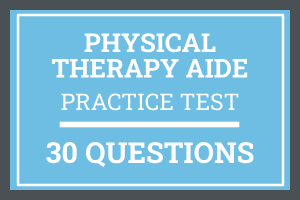Physical therapy aides work with physical therapists and physical therapist assistants.
They may greet patients, prepare treatment rooms, and position patients before or during treatment.
Physical therapy aides aren’t required to be certified, but they can help you advance your career.
To get your certification, you’ll need to complete a training program or have on-the-job experience.
The PTTC exam is given by the American Medical Certification Association.
The exam takes 2 hours and has 100 multiple-choice questions.
Before you take the PTTC exam, you should take our practice test to see if you are ready.
We cover the topics included in the exam, including anatomy and physiology, medical law and ethics, infection control, therapeutic modalities, and patient prep and positioning.
Physical Therapy Aide Certification Practice Test
Question 1 |
Diagnosing patients | |
Developing treatment plans | |
Assisting physical therapists with patient care | |
Administering medications |
Question 2 |
Assisting patients with exercises | |
Taking patient medical histories | |
Cleaning and organizing treatment areas | |
Interpreting diagnostic tests |
Question 3 |
To diagnose medical conditions | |
To provide emotional support to patients | |
To promote strength, flexibility, and endurance | |
To administer pain medications |
Question 4 |
Bend at the waist and lift with your back | |
Keep your back straight and lift with your legs | |
Twist your body while lifting | |
Use quick, jerking movements |
Question 5 |
Assessment, treatment planning, implementation, evaluation | |
Evaluation, assessment, implementation, treatment planning | |
Implementation, assessment, treatment planning, evaluation | |
Treatment planning, assessment, evaluation, implementation |
Question 6 |
Pounds | |
Inches or centimeters | |
Minutes | |
Degrees |
Question 7 |
Ultrasound | |
X-rays | |
Electrocardiogram (ECG) | |
Magnetic Resonance Imaging (MRI) |
Question 8 |
To teach patients how to swim | |
To improve a patient's ability to walk | |
To enhance flexibility and balance | |
To perform strength training exercises |
Question 9 |
Flexibility | |
Strength | |
Endurance | |
Stability |
Question 10 |
Apply directly to the skin without a barrier | |
Wrap in a thin cloth and apply for 20-30 minutes | |
Heat the cold pack before applying | |
Use cold packs only for muscle tightness, not swelling |
Question 11 |
Stand behind the patient and push the walker | |
Walk ahead of the patient and pull the walker | |
Stand on the side of the patient and hold the walker | |
Ask the patient to walk without the walker |
Question 12 |
Increasing pain levels | |
Decreasing range of motion | |
Improving strength and function | |
Avoiding all physical activity |
Question 13 |
To induce sleep in patients | |
To increase blood circulation and flexibility | |
To diagnose neurological disorders | |
To administer pain medication |
Question 14 |
Leg press | |
Hamstring stretch | |
Seated leg extension | |
Squats |
Question 15 |
Diagnosing medical conditions | |
Creating treatment plans | |
Collecting and recording data on patient performance | |
Administering medications |
Question 16 |
Acute inflammation | |
Muscle spasms | |
Joint stiffness | |
Recent surgery |
Question 17 |
To improve cardiovascular health | |
To enhance coordination and stability | |
To increase muscle size | |
To assess cognitive function |
Question 18 |
Scoliosis | |
Kyphosis | |
Lordosis | |
Osteoporosis |
Question 19 |
Twisting the body while lifting | |
Keeping the back straight and bending at the knees | |
Lifting with the back muscles | |
Using quick, jerking movements |
Question 20 |
To increase muscle size | |
To prevent joint stiffness | |
To induce relaxation in patients | |
To diagnose medical conditions |
Question 21 |
Assessment | |
Planning | |
Implementation | |
Evaluation |
Question 22 |
Ignoring safety hazards | |
Using equipment without proper training | |
Reporting unsafe conditions and incidents | |
Providing treatment in a cluttered space |
Question 23 |
To decrease joint flexibility | |
To induce muscle spasms | |
To improve joint mobility and function | |
To diagnose bone fractures |
Question 24 |
TENS unit | |
Hot pack | |
Crutches | |
Ultrasound machine |
Question 25 |
Allow the patient to stand up on their own | |
Provide a firm base of support and assist the patient to stand | |
Push the patient from behind to help them stand | |
Lift the patient from under their arms |
Question 26 |
Using complex medical terminology | |
Building rapport with parents and caregivers | |
Avoiding play and recreational activities | |
Maintaining a strictly formal approach |
Question 27 |
Avoid taking breaks to rest | |
Lift heavy objects without assistance | |
Use proper body mechanics and ergonomic techniques | |
Ignore early signs of discomfort or pain |
Question 28 |
To induce muscle spasms | |
To improve balance, coordination, and movement patterns | |
To administer pain medication | |
To diagnose neurological disorders |
Question 29 |
Withholding information from the patient | |
Providing written materials only | |
Using medical jargon extensively | |
Explaining exercises and treatment plans in a clear and understandable manner |
Question 30 |
Not washing hands regularly | |
Using the same equipment for multiple patients without cleaning | |
Wearing personal protective equipment (PPE) as needed | |
Ignoring signs of illness in patients and colleagues |






